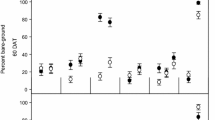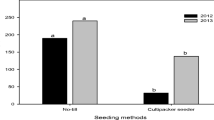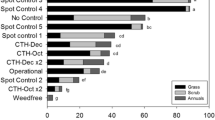Abstract
Weed interference limits switchgrass (Panicum virgatum L.) establishment from seed. Our objectives were to determine the effect of selected post-plant, preemergence herbicides on stand establishment and subsequent biomass yields of adapted upland switchgrass cultivars grown in three environments in the Central and Northern Great Plains. A separate experiment was conducted in eastern Nebraska to determine if there were any differences among switchgrass ecotypes for herbicide tolerance to the optimal herbicide combination. Herbicides applied immediately after planting were different concentrations of atrazine [Aatrex 4L®; 6-chloro-N-ethyl-N′-(1-methylethyl)-1,3,5-triazine-2,4-diamine], quinclorac (Paramount®; 3,7-Dichloro-8-quinolinecarboxylic acid), atrazine+quinclorac, imazapic {Plateau®; 2-[4,5-dihydro-4-methyl-4-(1-methylethyl)-5-oxo-1H-imidazol-2-yl]-5-methyl-3-pyridinecarboxylic acid}, and quinclorac+imazapic. Herbicide efficacy was determined by measuring stand frequency of occurrence and biomass yield the year after establishment. The application of quinclorac plus atrazine resulted in acceptable stands and high biomass yields. Imazapic often reduced switchgrass stands in comparison to the nontreated control and is not recommended for switchgrass establishment. In the multi-state trials, the herbicide by cultivar interaction was not significant for stands or biomass yields, indicating that the effects of herbicides on switchgrass stands and biomass yields were consistent over the upland cultivars used in the trials. No differences were detected among switchgrass lowland and upland ecotypes for tolerance to atrazine and quinclorac. Quinclorac, which provides effective control of grassy weeds, and herbicides such as atrazine which provide good broadleaf weed control are an excellent herbicide combination for establishing switchgrass for biomass production in the Great Plains and the Midwest.


Similar content being viewed by others
Abbreviations
- a.i.:
-
active ingredient
- PLS:
-
pure live seed
References
Bahler CC, Vogel KP, Moser LE (1984) Atrazine tolerance in warm-season grass seedlings. Agron J 76:891–895
BASF (2006) Plateau herbicide label. BASF Corp, Research Triangle Park
Liebig MA, Vogel KP, Schmer MR, Mitchell RB (2008) Soil carbon storage by switchgrass grown for bioenergy. Bioenergy Res 1:215–222
Littell RC, Milliken GA, Stroup WW, Wolfinger RD (1996) SAS system for mixed models. SAS Institute Inc., Cary
Martin AR, Moomaw RS, Vogel KP (1982) Warm-season grass establishment with atrazine. Agron J 74:916–920
Mitchell RB, Vogel KP, Sarath G (2008) Managing and enhancing switchgrass as a bioenergy feedstock. Biofuels, Bioproducts, & Biorefining 2:530–539
Perrin RK, Vogel KP, Schmer MR, Mitchell RB (2008) Farm-scale production cost of switchgrass for biomass. BioEnergy Res 1:91–97
Sanderson MA, Reed R, McLaughlin S, Wullschleger S, Conger B, Parrish D, Wolf D, Taliaferro C, Hopkins A, Ocumpaugh W, Hussey M, Read J, Tischler C (1996) Switchgrass as a sustainable bioenergy crop. Bioresour Technol 56:83–93
SAS Institute, Inc. (1999) SAS/STAT user’s guide, Version 8, Cary, NC
Schmer MR, Vogel KP, Mitchell RB, Moser LE, Eskridge KM, Perrin RK (2006) Establishment stand threshold on field-scale switchgrass grown as a bioenergy crop. Crop Sci 46:157–161
Vogel KP (1987) Seeding rates for establishing big bluestem and switchgrass with preemergence atrazine applications. Agron J 79:509–512
Vogel KP (2004) Switchgrass. In: Moser LE, Sollenberger L, Burson B (eds) Warm-season (C4) grasses. ASA-CSSA-SSSA Monograph, Madison, pp 561–588
Vogel KP, Masters RA (2001) Frequency grid—a simple tool for measuring grassland establishment. J Range Manage 54:653–655
Vogel KP, Mitchell RB (2008) Heterosis in switchgrass: biomass yield in swards. Crop Sci 48:2159–2164
Vogel KP, Brejda JJ, Walters DT, Buxton DR (2002) Switchgrass biomass production in the Midwest USA: harvest and nitrogen management. Agron J 94:413–420
Author information
Authors and Affiliations
Corresponding author
Additional information
This paper is a joint publication of the USDA-ARS and the Agricultural Research Division of the University of Nebraska and reports research involving pesticides. It does not contain recommendations for their use nor does it imply that uses discussed here have been registered. All uses of pesticides must be registered by appropriate state and/or federal agencies before they can be recommended. Mention of trade names or commercial products in this publication is solely for the purpose of providing specific information and does not imply recommendation or endorsement by the USDA or the University of Nebraska. Always read and follow label directions.
Rights and permissions
About this article
Cite this article
Mitchell, R.B., Vogel, K.P., Berdahl, J. et al. Herbicides for Establishing Switchgrass in the Central and Northern Great Plains. Bioenerg. Res. 3, 321–327 (2010). https://doi.org/10.1007/s12155-010-9084-4
Published:
Issue Date:
DOI: https://doi.org/10.1007/s12155-010-9084-4




